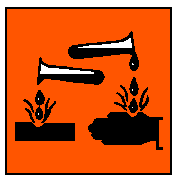International Chemical Safety Cards
| ANTIMONY TRICHLORIDE | ICSC: 1224 |
| ANTIMONY TRICHLORIDE Trichlorostibine Antimonous chloride SbCl3 Molecular mass: 228.1 CAS # 10025-91-9 RTECS # CC4900000 ICSC # 1224 UN # 1733 EC # 051-001-00-8 |
 |
| TYPES OF HAZARD/ EXPOSURE |
ACUTE HAZARDS/ SYMPTOMS |
PREVENTION | FIRST AID/ FIRE FIGHTING |
| FIRE | Not combustible. Gives off
irritating or toxic fumes (or gases) in a fire. |
|
In case of fire in the
surroundings: powder, carbon dioxide, NO water. |
| EXPLOSION | |
|
|
| EXPOSURE | |
AVOID ALL CONTACT! |
IN ALL CASES CONSULT A
DOCTOR! |
| INHALATION | Corrosive. Abdominal pain.
Burning sensation. Cough. Shortness of breath. Loss of appetite. |
Local exhaust or breathing
protection. |
Fresh air, rest.
Half-upright position. Refer for medical attention. |
| SKIN | Corrosive. Redness. Pain.
Blisters. |
Protective gloves.
Protective clothing. |
Remove contaminated
clothes. Rinse and then wash skin with water and soap. Refer for medical attention. |
| EYES | Corrosive. Redness. Pain.
Severe deep burns. |
Face shield or eye
protection in combination with breathing protection. |
First rinse with plenty of
water for several minutes (remove contact lenses if easily possible), then take to a
doctor. |
| INGESTION | Corrosive. Abdominal
cramps. Burning sensation. Nausea. Shock or collapse. Vomiting. |
Do not eat, drink, or smoke
during work. |
Rinse mouth. Do NOT induce
vomiting. Refer for medical attention. |
| SPILLAGE DISPOSAL | STORAGE | PACKAGING & LABELLING | ||
| Sweep spilled substance into
sealable containers. Carefully collect remainder, then remove to safe place (extra
personal protection: complete protective clothing including self-contained breathing
apparatus). |
Separated from food and
feedstuffs. Dry. Well closed. |
Do not transport with food
and feedstuffs. C symbol R: 34-37 S: (1/2-)26-45 UN Hazard Class: 8 UN Packing Group: II |
||
| SEE IMPORTANT INFORMATION ON BACK | ||||
|
||||